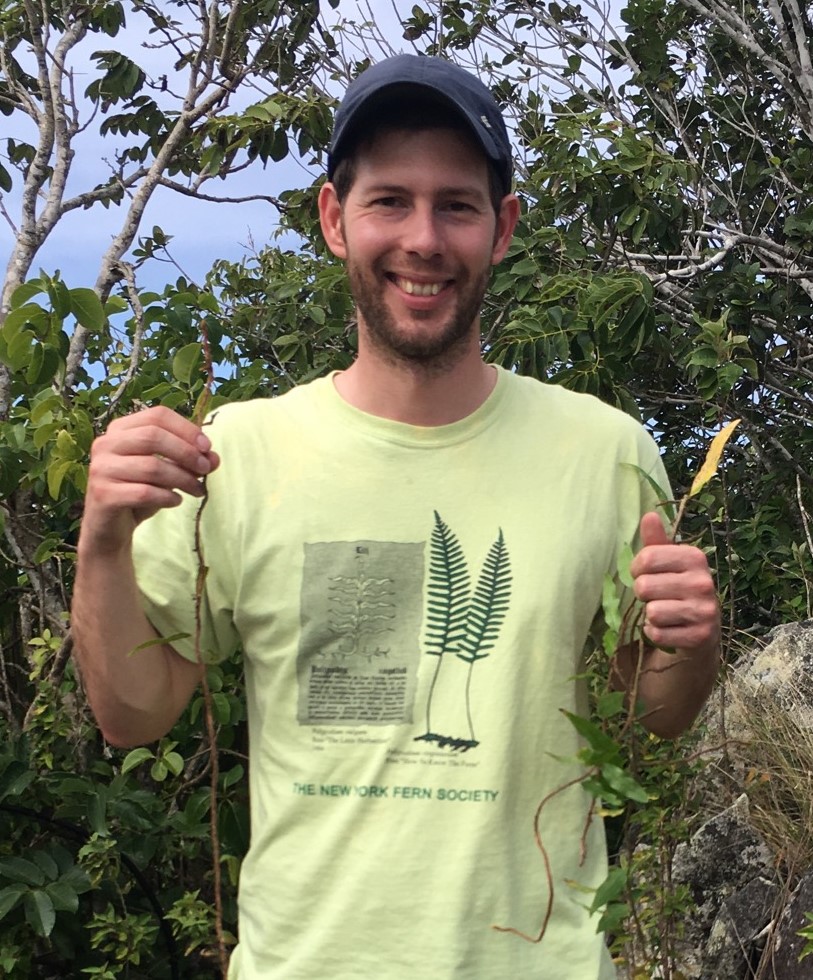
Donald McClelland ’00 received his AA and BA from Simon’s Rock, and later earned his PhD and MPhil from the Graduate Center of the City University of New York and the New York Botanical Garden. He is now an Associate Professor of Environmental Science at Simon’s Rock, where his research is focused primarily on taxonomy and systematics of the plant family Solanaceae, the floras of Montserrat and of eastern North America, and botanical conservation. He oversees the apiary, as well as honey and maple syrup production at the sugar shack on campus.
As a student, Donald contributed to the Simon’s Rock Herbarium — a collection of dried, pressed plant specimens that are systematically organized for scientific inquiry. When he returned as faculty, he had it recognized by the Index Herbariorum, a worldwide reference resource. Today, Simon’s Rock’s collection includes more than 3,000 specimens and growing.
He has also led many students studying ecology in the Signature Program in Montserrat. He lives in New Marlborough, Massachusetts, with his wife, fellow alum and Simon’s Rock Visiting Faculty in Music, Professor of Piano, Manon Hutton-DeWys ’01, and their two sons.
Summarize your Simon’s Rock experience in 12 words or less.
It was freeing, challenging, and informative. It yielded opportunities, friendships, and direction.
Are there plants you hope to bring back from Montserrat to study on campus?
My objective is to identify all of the plants on the island. Surprisingly, no one has done this yet on Montserrat so one of my research projects is compiling the flora of Montserrat, which is a career-long project. Since my first trip to Montserrat in 2017, I have brought back several hundred herbarium specimens towards this goal.
How can we all do our part in botanical conservation at home?
There’s a concept that was coined in the late 90’s called “plant blindness,” essentially defined as viewing plants as the backdrop, the inability to identify what plants one is seeing, or being unable to see plants individually. Step one would be to seek to have one’s plant blindness cured by engaging more with plants and learning about them. Start small and delve as deep as you can. Remember there is so much to learn about plants that no one will ever know it all, so just jump in. When I started learning about plants, I remember the moment I stopped seeing just green around me and started to see individual plants. Another practical step folks can take is to work on managing the invasive species on their own properties. I work on them at my own home each year, and it is a never-ending battle. But, if we all work on it on a small scale at home, we can have a large collective impact.
What are some of the native plants on the Simon’s Rock campus?
We have hundreds. Here are some of the charismatic ones that come to mind: First, the sugar maples. It might be easy to walk by and not notice them unless you’re up by the sugar shack, and you can see the trees tapped during sugaring season. White pines also dominate lower campus and the summit of the upper campus. They really serve to define our non-forested landscape. Also, black walnut trees, including a quite large one outside of the Dining Hall, which I bet most Rockers have sat under at some point. I have a special fondness for that species because I use it to dye fabric with students in my Ethnobotany course. Juglone, the brown dye it contains, is an isomer of the dye from henna, which people are perhaps more familiar with. I also love the smell of black walnuts. We had black walnut trees on our property when I was growing up. My dad would collect them, and we’d shell the nuts and dye t-shirts each year. It’s definitely a charismatic plant. In the fall, campus is also brightened by the goldenrods and asters, and they provide the last nectar flow for the honeybees in our apiary. When they bloom it is our sign to ensure that our bees are stocked with plenty of food for winter.
Why do you give to Simon’s Rock?
I realize that it seems a little strange to be paid by the college and then turn around and give money back to it. Perhaps the same thing would apply to another alum who questions their impetus for giving when they’re no longer receiving a direct benefit from the college, especially after having paid their tuition. However, I realized I receive long-term benefits: I met my wife here, my brother (Arthur McClelland ’97) went here, now I work here, and my colleagues are some of my best friends. Simon’s Rock has been and continues to be a major institution and driving force in my life, as it turns out. It is where I became really excited about plants, and my thesis on the flora of the woody plants on campus was the ticket to my PhD fellowship at the New York Botanical Garden. I now ask myself what I would do or how I would feel if Simon’s Rock didn’t exist. I think about what I would be missing and what the world would be missing if Simon’s Rock wasn’t here anymore. That’s why I give.